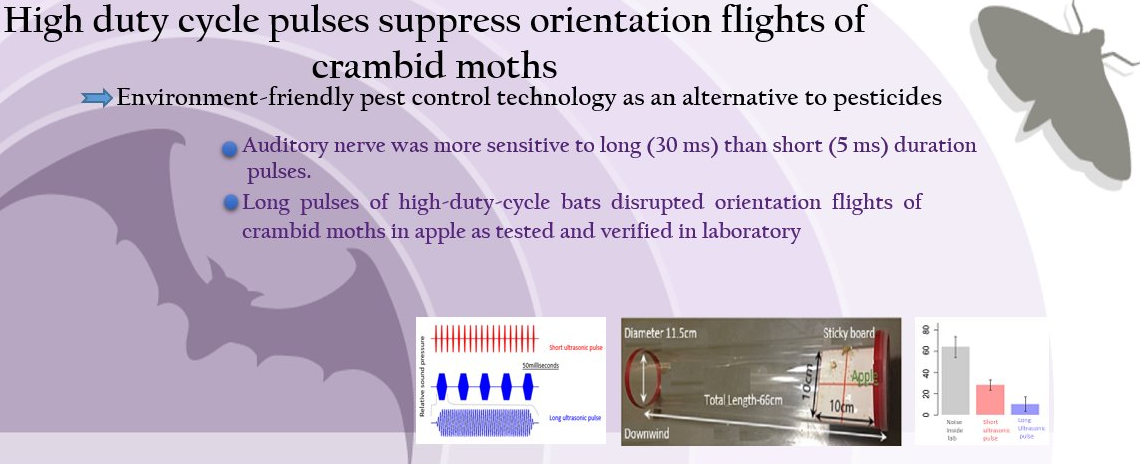
Published by
Ryo Nakano a, b, Fumio Iharaa, Koji Mishiroa, Masatoshi Toyamac, Satoshi Todaa a- Breeding and Pest Management Division, NARO Institute of Fruit Tree Science, 2-1 Fujimoto, Tsukuba, Ibaraki 305-8605, Japan b- Department of Biological Sciences, University of Toronto Scarborough, Toronto, ON M1C 1A4, Canada c- Grape and Persimmon Research Division, NARO Institute of Fruit Tree Science, 301-2 Mitsu, Akitsu, Higashi-hiroshima, Hiroshima 739-2494, Japan
Highlights
- Auditory nerve was more sensitive to long (30 ms) than short (5 ms) duration pulses.
- Long pulses of high-duty-cycle bats disrupted orientation flights of crambid moths.
- Species difference was found in nerve and behavioral responses to short pulses.
- Male flight of Ostrinia was not suppressed by short pulses of low-duty-cycle bats.
- Ultrasonic long duration pulses are more likely useful for repelling moth pests.
Abstract
Bat-and-moth is a good model system for understanding predator-prey interactions resulting from interspecific coevolution. Night-flying insects have been under predation pressure from echolocating bats for 65 Myr, pressuring vulnerable moths to evolve ultrasound detection and evasive maneuvers as counter tactics. Past studies of defensive behaviors against attacking bats have been biased toward noctuoid moth responses to short duration pulses of low-duty-cycle (LDC) bat calls. Depending on the region, however, moths have been exposed to predation pressure from high-duty-cycle (HDC) bats as well. Here, we reveal that long duration pulse of the sympatric HDC bat (e.g., greater horseshoe bat) is easily detected by the auditory nerve of Japanese crambid moths (yellow peach moth and Asian corn borer) and suppress both mate-finding flights of virgin males and host-finding flights of mated females. The hearing sensitivities for the duration of pulse stimuli significantly dropped non-linearly in both the two moth species as the pulse duration shortened. These hearing properties support the energy integrator model; however, the threshold reduction per doubling the duration has slightly larger than those of other moth species hitherto reported. And also, Asian corn borer showed a lower auditory sensitivity and a lower flight suppression to short duration pulse than yellow peach moth did. Therefore, flight disruption of moth might be more frequently achieved by the pulse structure of HDC calls. The combination of long pulses and inter-pulse intervals, which moths can readily continue detecting, will be useful for repelling moth pests.
Click here to read more



